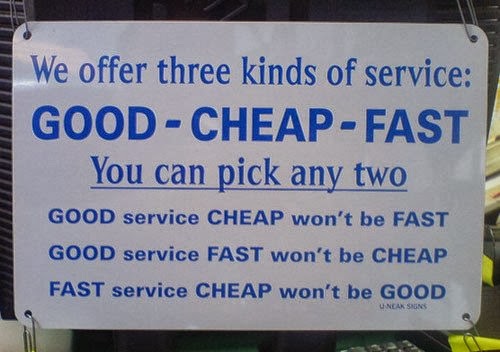Here’s our mantra: You need to know what people think, not what they say they think.
And, not so much a mantra as a universal truth – commodities notwithstanding – consumers may say they want “cheap,” but that’s usually not what they really expect. Oh, sure, they want to pay a little as possible, but it’s not the way they’ll actually behave when they get around to factoring in what they really expect. The “cheap” part is the rational aspect of decision making, but the expectations part is mostly emotional, and it’s a really good idea to have a fix on those expectations before creating products and taking them to market, because relying only on what people say, can take you down the wrong highway.
For example, four years ago we wrote about the Nano, from India’s Tata Motors. It sold for under $1,800.00. No, not a typo, it was priced to drive off the lot at just under eighteen hundred dollars! Sure, this was the Indian market, but it was conceived as the people’s car. Small, economical, and because the target audience said they’d buy such a car if it was “cheap.” And it was. Cheap, I mean. In lots of ways. Low sticker price, sure. But the car, too. It had a tiny, 0.6-liter engine with only 33 horsepower. The front and rear bumpers were plastic and most of the construction was glued, not welded. Seats couldn’t be adjusted. It had only one side mirror and windshield wiper, hand-cranked windows, a manual transmission and no airbags, hubcaps, or radio. And no AC. It didn’t even have a glove compartment. Sure the engine sometimes sounded like a broken lawnmower, but the Nano got 50 miles to the gallon, so what’s to complain about? Basic car? Sure. Cheap? For sure.
OK, back to the say-versus-think paradigm. Automotive brand success – all brand success, for that matter – is based upon how well a brand meets or exceeds customer expectations for the category Ideal. Expectations will vary by category and demography and geography, to be sure, but most of those expectations are emotionally-driven (no pun intended), many of which go unarticulated. And brands that are able to meet real expectation always do better in the marketplace. But, since folks said they would buy something cheap, Tata Motors produced a really cheap car and thought it was going to be a real growth area for them.
But after nearly 5 years, sales ran out of gas. Why? Well, even though consumers said they wanted “cheap,” there’s cheap (as in price/rational) and there’s cheap (as in image/emotional), and – as usually happens – emotion won, and Tata Motors lost. Turns out that consumers really wanted a more upscale image, expectations for automotive imagery being really high even among the more price-sensitive consumer segments, and pretty much true around the world. So Tata is bringing the Nano in for an image tune-up, to move it from “common” to “cool.”
With that in mind, the new models will have hubcaps. And a Bluetooth-enabled stereo with four speakers, a more comfortable interior, and chrome trim. Oh, and a glove compartment. The top-end Nano LX will cost about twice what the original models cost, so just under $3,600.00. Their new advertising tagline for the new models? “Celebrate Awesomeness.”
Of course, when it comes to “awesomeness,” you may expect something else. Which is probably why it’s a good idea to measure what your target audience really thinks and really expects before you disappoint them – and your shareholders.
Connect with Robert on LinkedIn.
Find out more about what makes customer loyalty happen and how Brand Keys metrics is able to predict future consumer behavior: brandkeys.com. Visit our YouTube channel to learn more about Brand Keys methodology, applications and case studies.
Share this:

